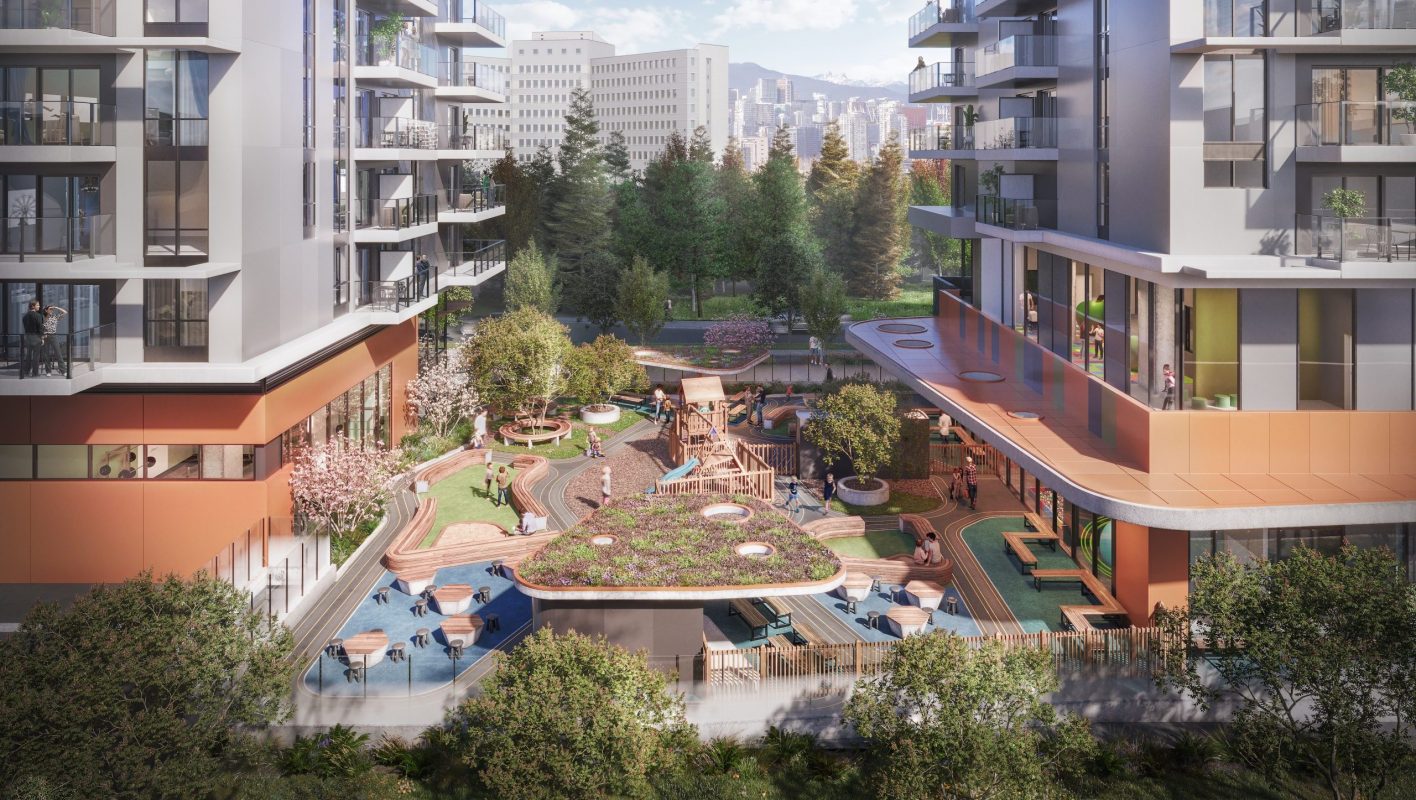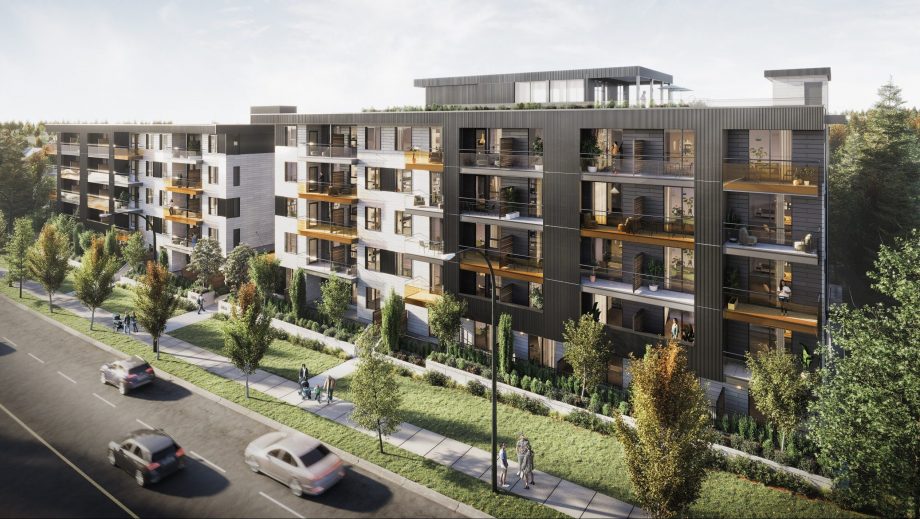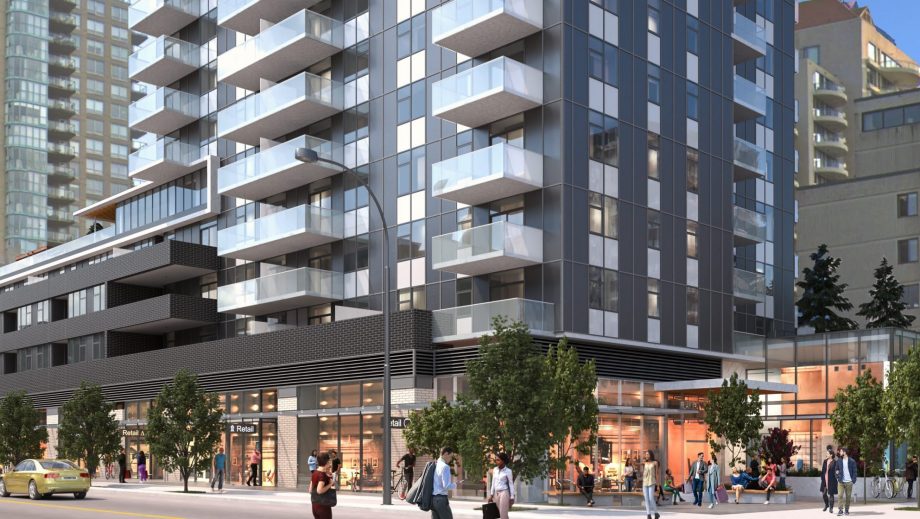

By: Kerry Gold
March 8, 2024
With Metro Vancouver projected to add another one million people in 17 years, it’s no wonder that the province has unrolled so much legislation aimed at increasing density, particularly around transit.
If the projected is accurate, four million people will live in the region, and many of them will have kids. That makes high-rise living for families an essential part of the housing program. However, we have a long way to go, Simon Fraser University City Program director Andy Yan says.
He found that only 15 per cent of Vancouver children under the age of 14 are living in multifamily buildings are more than five storeys, either owned or rented, according to census numbers for 2021. In Burnaby, home to a lot of skyscrapers, only 17 per cent of kids live in these units. In Surrey, it’s 2 per cent. Region-wide, it’s 8 per cent of kids. In Toronto, by contrast, 35 per cent of children live in multifamily buildings.
Part of the problem for the Vancouver region, developer and real estate consultant Michael Geller says, is the drive for developers to sell enough units to qualify for financing, and in B.C. they typically only have a year to do so. With that kinds of pressure, they cater to the investor who’s looking for studios and one-bedrooms to rent out, which is why two- and three-bedroom family units are often an afterthought unless there is government policy in place requiring a certain percentage of family units. He recalls recently with a high-profile marketer who was pushing for small investor apartments in a project that didn’t even need to qualify for financing. But that is the Vancouver way.
“Other than government-funded projects and non-profit projects, it’s very rare that a market developer would develop or design a market condo or even rental project for families with children,” says Mr. Geller, who recently spoke on a panel about the reasons family housing doesn’t get built. “I know that most of the two-bedrooms we provide, we provide them because it’s an obligation, but rarely do we design those suites thinking there may be a toddler living in that unit.
“One reason is because, if it’s new building, so much of the development program is based on what you can presell because if you can’t presell enough units, you won’t get your financing. And you might ask, why would the investors buy them? One reason is that the building not be finished for four years, and most families are not in a position to buy something today that won’t be completed for four years.”
Mr. Geller started his career working for Canada Mortgage and Housing Corp., and he did a lot of social housing.
“In social housing projects, funded by CMHC, we were designing for families with children, or empty nesters, rather than investors.”
As well, developers of dense buildings generally don’t put a lot of thought into family amenities, he adds. Play areas for children are kept off to the side and out of sight if they exist at all. Eating areas often involve sitting on stools at a kitchen counter, and there is little storage area for strollers and toys. “Vancouver, the development of housing has always been about form following financing,” Mr. Yan says. “The needs of children should take precedence over granite countertops and walk-in closets. And it’s not just about affordability, but also size, design and amenities.”
There are signs, however that developers are properly stepping into the family-friendly space, especially rental. Because of interest rates, the condo market isn’t as financially viable as it has been in previous years, so many developers are pivoting to rental, which is in demand. Government policies have helped, including the federal break on GST for rental construction. He cites census data that show renter households grew by 21.5 per cent by 2021, compared with owner households, which only grew by 8.4 per cent.
Developer Brent Sawchyn is proposing B.C.’s first 24-hour daycare for his site at West 13th Avenue and Willow Street, across from Vancouver General Hospital. It will serve hospital staff who work the night shift, and will be part of a two-toner, 354-unit purpose-built rental development that will include larger indoor and outdoor play areas. The site is currently duplexes that they assembled and purchased, so it won’t involve displacement of renters. Mr. Sawchyn says his company is not looking at older rental buildings in the Broadway Plan area because of the complexity of the city’s tenant relocation and protection policy and because of “sensitivities” around displacing exiting renters.
His Willow Street project is responding to the Broadway Plan requirement for a minimum 35 per cent of two or more bedrooms in market rental housing. The plan requires three-bedroom units “wherever possible.” In social housing projects suitable to families, the target is 50-per-cent two- and three-bedroom units.
“It’s an example of how the industry is trying to respond to what the needs will be,” says Mr. Sawchyn, who submitted a rezoning application for the project, at 816-860 W. 13th Ave. and 2915-2925 Willow St.
“It’s a different paradigm that we are looking at,” he adds. “I think maybe the luxury of opening the back door and letting your kid play in a backyard in a set surrounding is not going to be attainable for al ot of people going forward.
“Here in Vancouver the universe of single-family homes is essentially diminishing,” he says. “In various cohort groups of people have decided to give up on home ownership and have decided to just focus on rental as a way of housing for their future.”
His company, PC Urban Properties has about 900 apartment units under construction and another 1,100 proposed for Vancouver. Their focus is the Lower Mainland, but they also have projects in Victoria and Kelowna.
“As we go forward, we probably need to be more cognizant in developing of these projects to accommodate families.”
But there are challenges, including policies that he says overcomplicate the delivery of housing. He cites the example of his Kerrisdale site where they benefited form the federal government’s removal of GST on rental housing, which saved almost $10 million. But the Metro Vancouver and city fees amounted to $12-million. It takes a bout 15 or more months to get to a public hearing and another year to get the development permit.
“The costs that go into a rental project, unfortunately, find their way to what a tenant has to pay in rent, and the larger the apartment home, unfortunately, the more the rent is going to be.”
Downtown rentals are at around $6 per square foot in the new projects, or $3,000 for a 500-square foot apartment.
Like many, he says a big part of the problem is that the federal government stopped building subsidized housing for families decades ago.
“The federal government abdicated their responsibility. Now the older stock by default has become our affordable supply because we haven’t built housing since the 1980’s.”
Affordability is a continuing problem, but in the meantime, developers can step up amenities to attract families. Concert Properties just launched a lending library at its East Vancouver 28-acre Collingwood Village development, where residents can now borrow kitchen appliances, tools, sports gear as part of a partnership with a lending library called the Thingery. The five-building complex has 704 rental units and has focused on family amenities such as play areas and tennis and basketball courts. The new lending library saves families money and reduces waste, Grant Knowles, Concert Properties vice-president of property management, says in an e-mail.
“There is a growing need to build communities and residential areas that can support families,” Mr. Knowles says.




